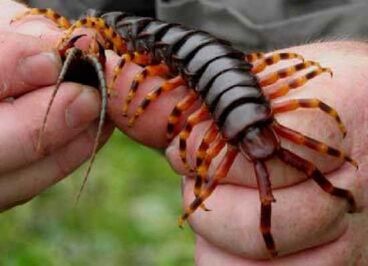
Giant Yellowleg Centipede being held by a Human
Scolopendra Gigantea Robusta or the Giant Yellowleg Centipede is the largest representative of the genus Scolopendra, regularly reaching lengths of 26 cm (10 in) and can exceed 30 cm (12 in).[1] It inhabits the northern and western regions of South America and the islands of Trinidad, Puerto Rico, Saint Martin, Saint Thomas, U.S. Virgin Islands, Jamaica, Grenada, and Hispaniola. It is carnivorous, feeding on insects, lizards, frogs, birds, mice, and even bats.[2] It is also known to prey on tarantulas.[3] The body consists of 21 to 23 segments which are coppery red or maroon in color, each with a pair of yellow-tinted legs; the legs are adapted for fast walking. The centipede has modified claws called forcipules which curve around its head and can deliver venom into its prey. The extremely potent venom, containing acetylcholine, histamine and serotonin (pain mediators), proteases and a cardiodepressant factor, is toxic to humans and causes severe swelling, chills, fever, and weakness.

Giant Yellowleg Centipede scaring Ann Darrow in King Kong
Although bites are painful, they are very unlikely to be fatal to humans.
- Kingdom: Animalia
- Phyllum: Arthropoda
- Class: Chilopoda
- Order: Scolopendromorpha
- Family: Scolopendridae
- Genus: Scolopendra
- Species: Gigantea
- Subspecies: Robusta
Appearances[]
- King Kong
Mentions[]
- Walking with Monsters
- Prehistoric Park
- Primeval
